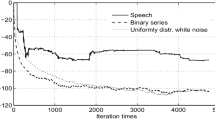Abstract
In this paper, we explore the application of a common operator used in systems theory, viz., the delta operator, to formulate a unified theory of multichannel blind deconvolution (MBD) which is valid in both discrete and continuous time domains. Apart from providing a unified treatment of MBD problems, this formulation permits a smooth transition of the demixer from a discrete time domain to a continuous time domain when the sampling rate is high. Furthermore we give a unified treatment of a balanced parameterized state space formulation to solving the MBD problem in both discrete and continuous time domains when the number of states is unknown.
Similar content being viewed by others
References
Cichocki A. and Amari S. (2002). Adaptive Blind Signal and Image Processing: Learning Algorithms and Applications. Wiley, West Sussex
Haykin S. (1994). Blind Deconvolution. Prentice-Hall, New Jersey
Lambert, R.H.: Multichannel blind deconvolution: FIR matrix algebra and separation of multipath mixtures. PhD Thesis, University of Southern California (1996)
Attias H. and Schreiner C.E. (1998). Blind source separation and deconvolution: the dynamic component analysis algorithm. Neural Comput. 10(6): 1373–1424
Valpola H. and Karhunen J. (2002). An unsupervised ensemble learning method for nonlinear dynamic state-space models. Neural Comput. 14(11): 2647–2692
Zhang, L., Amari, S., Cichocki, A.: Natural gradient approach to blind separation of over- and under-complete mixtures. In: Proceeding of the 1st International Workshop on Independent Component Analysis and Signal Separation, pp. 455–460 (1999)
Zhang L. and Cichocki A. (2000). Blind deconvolution of dynamical systems: a state space approach. J. Signal Proces. 4(2): 111–130
Xia, B., Zhang, L.: Multichannel blind deconvolution of non- minimum phase system using cascade structure. In: The 11th International Conference on Neural Information Processing, ICONIP, pp. 1186–1191 (2004)
Taylor, R.M. Jr, Mili, L., Zaghloul, A.I.: MOptimal multichannel blind deconvolution for parameterized channels and known source densities. Technical Report, Alexandria Research Institute of Virginia Tech (2005)
Salam, F.M., Erten, G., Waheed, K.: Blind source recovery: algorithms for static and dynamic environments. In: NNS-IEEE International Joint Conference on Neural Networks, IJCNN (2001)
Erten G. and Salam F. (1998). Voice extraction by on-line signal separation and recovery. IEEE Trans. on Circuits Systems II: Analog Digital Signal Proces. 46(7): 915–922
Amari, S., Douglas, S., Cichocki, A., Yang, H.H.: Multichannel blind deconvolution and equalization using the natural gradient. In: Proceedings of IEEE International Workshop on Wireless Communication, pp. 101–104 (1997)
Torkkola, K.: Blind deconvolution, information maximization, and recursive filters. In: Proceedings of the IEEE International Conference on Acoustics, Speech and Signal Processing, pp. 21–24 (1997)
Goodwin G.C., Middleton R.H. and Poor H.C. (1992). High-speed digital signal processing and control. Proc. IEEE 80(2): 240–259
Middleton, R.H., Goodwin, G.C.: Digital Control and Estimation: A Unified Aprroach. Prentice Hall, Englewood Cliffs (1990)
Amari S. (1998). Natural gradient working efficiently in learning. Neural Comput. 10(2): 251–276
Tsoi, A.C., Ma, L.S.: Blind deconvolution of dynamical system using a balanced parameterised state space approach. In: IEEE International Conference on Acoustics, Speech, and Signal Processing, ICASSP, vol. 4, pp. 309–312 (2003)
Glover K. (1984). All optimal hankel norm approximations of linear multivariable systems and L ∞ error bounds. International J. Control 39: 1115–1193
Chou C.T. and Maciejowski J.M. (1997). System Identification using balanced parametrizations. IEEE Trans. Autom. Control 42(7): 956–974
Nandi A.K. (1999). Blind Estimation Using Higher-Order Statistics. Kluwer, Dordrecht
Waheed, K., Salam, F.M.: A data-derived quadratic independence measure for adaptive blind source recovery in practical applications. In: 45th IEEE International Midwest Symposium on Circuits and Systems, vol. 3, pp. 473–476 (2002)
Choudrey R.A.: Variational methods for Bayesian independent component analysis. PhD Thesis, University of Oxford (2002)
Moddemeijer R. (1989). On estimation of entropy and mutual information of continuous distributions. Signal Proces. 16(3): 233–246
Strehl, A.: Relationship-based clustering and cluster ensembles for high-dimensional Data Mining. PhD Thesis, The University of Texas at Austin (2002)
Newman M.J. and Holmes D.G. (2003). Delta operator digital filters for high performance inverter applocations. IEEE Trans. Power Electron. 18: 447–454
Agoston A., Pepper S., Norton R., Ebner J. and Schoen K. (2003). 100GHz through-line sampler system with sampling rates in excess of 10 Gsamples/second. IEEE MTT-S Int. Microwave Symp. Digest 3: 519–1521
Moody, J., Wu, L.: Statistical analysis of tick-by-tick foreign exchange data. In: Proceedings of the High Frequency Data in Finance Conference, Zurich (1995)
Breton, D., Deslagnes, E.: Very high dynamic range and high-sampling rate VME digitizing board for physics experiments. In: Proceedings 10TH Workshop on Electronics for LHC Experiments and Future Experiments, Boston (2004)
Lee T.W. (1998). Independent Component Analysis: Theory and Applications. Kluwer, Dordrecht
Zhang L., Cichocki A. and Amari S. (1999). Natural gradient algorithm for blind separation of overdetermined mixture with additive noise. IEEE Signal Process. Lett. 6(11): 293–295
MacKay D.J.C. (2003). Information Theory, Inference and Learning Algorithms. Cambridge University Press, Cambridge
Choudrey, R.A., Roberts, S.J.: Flexible Bayesian independent component analysis for blind source separation. In: International Workshop on Independent Component Analysis and Blind Signal Separation (2001)
Akaike, H.: Information theory and an extension of maximum likelihood principle. In: Proceedings of the Second International Symposium on Information Theory (1973)
Raftery A.E. (1986). Choosing models for cross-classifications. Am. Sociol. Rev. 51: 145–146
Rissanen J. (1978). Modeling by shortest data description. Automatica 14: 465–471
Rissanen J. (1982). Estimation of structure by minimum description length. Circuits Systems Signal Process 1(3–4): 395–406
De Moor B. and Golub G. (1991). The restricted singular value decomposition: properties and applications. SIAM J. Matrix Anal. Appl. 12(3): 401–425
Vandewalle, J., De Moor, B.: On the use of the singular value decomposition in identification and signal processing. In: Proc. of the Workshop of the NATO Advanced Study Institute on Numerical Linear Algebra, Digital Signal Processing and Parallel Algorithms, pp. 321–361 (1988)
Jung T.-P., Makeig S., McKeown M.J., Bell A.J., Lee T.-W. and Sejnowski T.J. (2001). Imaging brain dynamics using independent component analysis. Proc. IEEE 89(7): 1107–1122
Author information
Authors and Affiliations
Corresponding author
Rights and permissions
About this article
Cite this article
Ma, L., Tsoi, A.C. A unified balanced approach to multichannel blind deconvolution. SIViP 1, 369–384 (2007). https://doi.org/10.1007/s11760-007-0030-7
Received:
Revised:
Accepted:
Published:
Issue Date:
DOI: https://doi.org/10.1007/s11760-007-0030-7




